DeWalt DC515B Handleiding
DeWalt
Stofzuiger
DC515B
Bekijk gratis de handleiding van DeWalt DC515B (7 pagina’s), behorend tot de categorie Stofzuiger. Deze gids werd als nuttig beoordeeld door 91 mensen en kreeg gemiddeld 4.6 sterren uit 46 reviews. Heb je een vraag over DeWalt DC515B of wil je andere gebruikers van dit product iets vragen? Stel een vraag
Pagina 1/7

INSTRUCTION MANUAL
GUIDE D'UTILISATION
MANUAL DE INSTRUCCIONES
DC515
Cordless 18V 1/2 Gallon Portable Vacuum
Aspirateur portatif sans fil 1/2 gallon 18 V
Aspiradora inalámbrica portátil de 1,8 litros (1/2 galón) de 18 V
INSTRUCTIVO DE OPERACIÓN, CENTROS DE SERVICIO
Y PÓLIZA DE GARANTÍA. LÉASE ESTE ADVERTENCIA:
INSTRUCTIVO ANTES DE USAR EL PRODUCTO.
D WALT Industrial Tool Co., 701 East Joppa Road, Baltimore, MD 21286E
(JUN09) Part No. N037112 DC515 Copyright © 2005, 2009
The following are trademarks for one or more D WALT power tools: the yellow and black color scheme; the E
“D” shaped air intake grill; the array of pyramids on the handgrip; the kit box configuration; and the array
of lozenge-shaped humps on the surface of the tool.
Defi nitions: Safety Guidelines
The definitions below describe the level of severity for each signal word. Please read
the manual and pay attention to these symbols.
DANGER:
Indicates an imminently hazardous situation which, if not avoided,
will
result in death or serious injury.
WARNING: could Indicates a potentially hazardous situation which, if not avoided,
result in death or serious injury.
CAUTION: Indicates a potentially hazardous situation which, if not avoided, may
result in minor or moderate injury.
NOTICE: indicates a practice not related to personal injury which, if not avoided,
may result in property damage.
IF YOU HAVE ANY QUESTIONS OR COMMENTS ABOUT THIS OR ANY DEWALT TOOL,
CALL US TOLL FREE AT 1-800-4-DEWALT (1-800-433-9258)
Important Safety Warnings and
Instructions
TO REDUCE RISK OF INJURY
• Before any use, be sure everyone using this vacuum reads and understands all safety
instructions and other information contained in this manual.
• Save these instructions and review frequently prior to use and in instructing others.
When using an electric vacuum, basic safety precautions should always be followed to reduce
risk of fire, electric shock, and personal injury, including the following:
READ ALL INSTRUCTIONS BEFORE USING VACUUM
WARNING: To reduce the risk of fire, electric shock, or injury:
• DO NOT leave vacuum with battery installed. Remove battery from tool when not in use and
before servicing.
• DO NOT allow vacuum to be used as a toy. Close attention is necessary when used by or
near children.
• USE ONLY as described in this manual. Use only manufacturer's recommended
attachments.
• DO NOT use with damaged cord or plug. If vacuum is not working as it should, has been
dropped, damaged, left outdoors, or dropped into water, return it to a service center.
• DO NOT pull or carry by cord, use cord as a handle, close a door on cord, or pull cord
around sharp edges or corners. Keep cord away from heated surfaces.
• DO NOT handle plug or vacuum with wet hands.
• KEEP hair, loose clothing, fingers, and all parts of body away from openings and moving
parts.
• TURN OFF all controls before removing battery.
• USE EXTRA CARE when cleaning on stairs.
• DO NOT use to pick up flammable or combustible liquids such as gasoline or use in areas
where they may be present.
• DO NOT pick up anything that is burning or smoking, such as cigarettes, matches or hot
ashes.
• STORE IDLE TOOLS. When not in use, the v should be stored in a dry, high or acuum
locked up place – out of reach of children.
• MAINTAIN TOOL WITH CARE. Keep fan area clean for best and safest performance.
Follow instructions for proper maintenance.
• DO NOT attempt to repair the vacuum. To assure product safety and reliability, repairs,
maintenance, and adjustments should be performed by authorized DEWALT service
centers.
• DO NOT unplug by pulling on cord. To unplug, grasp the plug, not the cord.
• DO NOT use without filter in place.
• DO NOT use in areas where explosive vapors may be present.
• DO NOT use to pick up explosive dust, or in areas where air contains explosive dust such
as coal, grain, or other combustible material.
• Static shocks are possible in dry areas or when the relative humidity of the air is low. This is
only temporary and does not affect the use of the vacuum. To reduce the frequency of static
shocks, add moisture to the air with a console or installed humidifier.
• TO AVOID spontaneous combustion, empty tank after each use.
• DO NOT put any objects into openings. Do not use with any opening blocked; keep free of
dust, lint, hair and everything that may reduce air flow.
• Do not allow the cord to hang over the edge of a table or counter or touch hot
surfaces. The unit should be placed or mounted away from sinks and hot surfaces.
WARNING: Some dust created by this product contains chemicals known to State of
California to cause cancer, birth defects or other reproductive harm. Some examples of these
chemicals are:
• compounds in fertilizers
• compounds in insecticides, herbicides and pesticides
• arsenic and chromium from chemically treated lumber
To reduce your exposure to these chemicals, wear approved safety equipment such as dust
masks that are specially designed to filter out microscopic particles.
• DO NOT place outlet of vacuum near eyes or ears when operating.
• DISCONNECT BATTERY PACK FROM VACUUM BEFORE MAKING ANY
ADJUSTMENTS CHANGING ACCESSORIES, SERVICING, MOVING, OR STORING
THE VACUUM. Such preventative safety measures reduce the risk of starting the tool
accidentally.
• AVOID ACCIDENTAL STARTING. Be sure the switch is in the OFF position before
inserting the battery pack or plugging the vacuum into a wall outlet.
• USE RECOMMENDED ACCESSORIES. Consult the instruction manual for recommended
accessories. The use of improper accessories may cause risk of injury to persons.
• NEVER STAND ON VACUUM. Serious injury could occur if the vacuum is tipped.
• NEVER LEAVE VACUUM RUNNING UNATTENDED. TURN POWER OFF.
• KEEP YOUR WORK AREA CLEAN AND WELL LIT. Cluttered benches and dark areas
invite accidents.
• AVOID BODY CONTACT WITH GROUNDED SURFACES SUCH AS PIPES, RADIATORS,
RANGES AND REFRIGERATORS. There is an increased risk of electric shock if your body
is grounded.
• DO NOT OVERREACH. KEEP PROPER FOOTING AND BALANCE AT ALL TIMES.
Proper footing and balance enables better control of the vacuum in unexpected situations.
• USE SAFETY EQUIPMENT. ALWAYS WEAR EYE PROTECTION. Dust mask, non-skid
safety shoes, hard hat, or hearing protection must be used for appropriate conditions.
• DO NOT USE TOOL IF SWITCH DOES NOT TURN IT ON OR OFF. Any tool that cannot
be controlled with the switch is dangerous and must be repaired.
• SERVICE MUST BE PERFORMED ONLY BY QUALIFIED REPAIR PERSONNEL.
Service or maintenance performed by unqualified personnel could result in a risk of injury.
• WHEN SERVICING, USE ONLY IDENTICAL REPLACEMENT PARTS. FOLLOW
INSTRUCTIONS IN THE MAINTENANCE SECTION OF THIS MANUAL. Use of
unauthorized parts or failure to follow maintenance instructions may create a risk of electric
shock or injury.
• DON’T EXPOSE VACUUM TO RAIN. Store indoors.
• WHEN OPERATING A VACUUM OUTSIDE, USE AN OUTDOOR EXTENSION CORD
MARKED “W-A” OR “W.” These cords are rated for outdoor use and reduce the risk of
electric shock.
Additional Specifi c Safety Rules for All Battery
Operated Tools
• A battery operated tool with integral batteries or a separate battery pack must be
recharged only with the specified charger for the battery. A charger that may be
suitable for one type of battery may create a risk of fire when used with another battery.
• Use battery operated tool only with the specifically designed battery pack. Use of any
other batteries may create a risk of fire.
• Disconnect battery pack from tool or place the switch in the locked or off position
before making any adjustments, changing accessories, or storing the tool. Such
preventative safety measures reduce the risk of starting the tool accidentally.
• When battery pack is not in use, keep it away from other metal objects like: paper
clips, coins, keys, nails, screws, or other small metal objects that can make a
connection from one terminal to another. Shorting the battery terminals together may
cause sparks, burns, or a fire.
• The label on your tool may include the following symbols. The symbols and their definitions
are as follows:
V ......................volts A ......................amperes
Hz ....................hertz W .....................watts
min ..................minutes ................... alternating current
...............direct current ...................alternating or direct current
....................Class I Construction no ....................no load speed
........................(grounded) ....................earthing terminal
....................Class II Constr uction .....................safety alert symbol
........................(double insulated) BPM ................beats per minute
…/min .............per minute RPM ................revolutions per minute
IPM..................impacts per minute
Important Safety Instructions for All Battery Packs
When ordering replacement battery packs, be sure to include catalog number and voltage.
Consult the chart at the end of this manual for compatibility of chargers and battery packs.
The battery pack is not fully charged out of the carton. Before using the battery pack and
charger, read the safety instructions below. Then follow charging procedures outlined.
READ ALL INSTRUCTIONS
• Do not charge or use battery in explosive atmospheres, such as in the presence of
flammable liquids, gases or dust. Inserting or removing the battery from the charger may
ignite the dust or fumes.
• NEVER force battery pack into charger. DO NOT modify battery pack in any way
to fit into a non-compatible charger as battery pack may rupture causing serious
personal injury. Consult the chart at the end of this manual for compatibility of batteries
and chargers.
• Charge the battery packs only in DEWALT chargers.
• DO NOT splash or immerse in water or other liquids.
• Do not store or use the tool and battery pack in locations where the temperature
may reach or exceed 105°F (40˚C) (such as outside sheds or metal buildings in
summer).
DANGER: Electrocution hazard. Never attempt to open the battery pack for any reason.
If battery pack case is cracked or damaged, do not insert into charger. Do not crush, drop or
damage battery pack. Do not use a battery pack or charger that has received a sharp blow,
been dropped, run over or damaged in any way (i.e., pierced with a nail, hit with a hammer,
stepped on). Electric shock or electrocution may result. Damaged battery packs should be
returned to service center for recycling.
NOTE: Battery storage and carrying caps are provided for use whenever the
battery is out of the tool or charger. Remove cap before placing battery in
charger or tool.
WARNING: Fire hazard. Do not store or carry battery so that metal
objects can contact exposed battery terminals. For example, do not
place battery in aprons, pockets, tool boxes, product kit boxes, drawers, etc., with loose nails,
screws, keys, etc. without battery cap. Transporting batteries can possibly cause fires if the
battery terminals inadvertently come in contact with conductive materials such as keys,
coins, hand tools and the like. The US Department of Transportation Hazardous Material
Regulations (HMR) actually prohibit transporting batteries in commerce or on airplanes (i.e.,
packed in suitcases and carry-on luggage) UNLESS they are properly protected from short
circuits. So when transporting individual batteries, make sure that the battery terminals are
protected and well insulated from materials that could contact them and cause a short circuit.
SPECIFIC SAFETY INSTRUCTIONS FOR NICKEL CADMIUM (NiCd) OR NICKEL METAL
HYDRIDE (NiMH)
• Do not incinerate the battery pack even if it is severely damaged or is completely
worn out. The battery pack can explode in a fire.
• A small leakage of liquid from the battery pack cells may occur under extreme usage
or temperature conditions. This does not indicate a failure.
However, if the outer seal is broken:
a. and the battery liquid gets on your skin, immediately wash with soap and water for
several minutes.
b. and the battery liquid gets into your eyes, flush them with clean water for a minimum of
10 minutes and seek immediate medical attention. ( The liquid is 25-35% Medical note:
solution of potassium hydroxide.)
SPECIFIC SAFETY INSTRUCTIONS FOR LITHIUM ION (Li-Ion)
• Do not incinerate the battery pack even if it is severely damaged or is completely
worn out. The battery pack can explode in a fire. Toxic fumes and materials are created
when lithium ion battery packs are burned.
• If battery contents come into contact with the skin, immediately wash area with mild
soap and water. If battery liquid gets into the eye, rinse water over the open eye for 15
minutes or until irritation ceases. If medical attention is needed, the battery electrolyte is
composed of a mixture of liquid organic carbonates and lithium salts.
• Contents of opened battery cells may cause respiratory irritation. Provide fresh air. If
symptoms persists, seek medical attention.
WARNING: Burn hazard. Battery liquid may be flammable if exposed to spark or flame.
The RBRC™ Seal
The RBRC™ (Rechargeable Battery Recycling Corp oration) Seal on the nickel
cadmium, nickel metal hydride or lithium ion batteries (or battery packs) indicate
that the costs to recycle these batteries (or battery packs) at the end of their
useful life have already been paid by DEWALT. In some areas, it is illegal to place
spent nickel cadmium, nickel metal hydride or lithium ion batteries in the trash or
municipal solid waste stream and the RBRC program provides an environmentally
conscious alternative.
RBRC™ in cooperation with DEWALT and other battery users, has established programs in
the United States and Canada to facilitate the collection of spent nickel cadmium, nickel metal
hydride or lithium ion batteries. Help protect our environment and conserve natural resources
by returning the spent nickel cadmium and nickel cadmium, nickel metal hydride or lithium ion
batteries to an authorized DEWALT service center or to your local retailer for recycling. You
may also contact your local recycling center for information on where to drop off the spent
battery.
RBRC™ is a registered trademark of the Rechargeable Battery Recycling Corporation.
Important Safety Instructions for All Battery Chargers
SAVE THESE INSTRUCTIONS: This manual contains important safety and operating
instructions for battery chargers.
• Before using charger, read all instructions and cautionary markings on charger, battery
pack, and product using battery pack.
DANGER: Electrocution hazard. 120 volts are present at charging terminals. Do not probe
with conductive objects. Electric shock or electrocution may result.
WARNING: Shock hazard. Do not allow any liquid to get inside charger. Electric shock may
result.
CAUTION: Burn hazard. To reduce the risk of injury, charge only DEWALT rechargeable
batteries. Other types of batteries may burst causing personal injury and damage.
CAUTION: Under certain conditions, with the charger plugged in to the power supply, the
exposed charging contacts inside the charger can be shorted by foreign material. Foreign
materials of a conductive nature such as, but not limited to, steel wool, aluminum foil, or any
buildup of metallic particles should be kept away from charger cavities. Always unplug the
charger from the power supply when there is no battery pack in the cavity. Unplug charger
before attempting to clean.
• DO NOT attempt to charge the battery pack with any chargers other than the ones in
this manual. The charger and batter y pack are specifically designed to work together.
• These chargers are not intended for any uses other than charging DEWALT
rechargeable batteries. Any other uses may result in risk of fire, electric shock or
electrocution.
• Do not expose charger to rain or snow.
• Pull by plug rather than cord when disconnecting charger. This will reduce risk of
damage to electric plug and cord.
• Make sure that cord is located so that it will not be stepped on, tripped over, or
otherwise subjected to damage or stress.
• Do not use an extension cord unless it is absolutely necessary. Use of improper
extension cord could result in risk of fire, electric shock, or electrocution.
• When operating a power tool outdoors, use an extension cord suitable for outdoor
use. Use of a cord suitable for outdoor use reduces the risk of electric shock.
• An extension cord must have adequate wire size (AWG or American Wire Gauge) for
safety. The smaller the gauge number of the wire, the greater the capacity of the cable, that
is 16 gauge has more capacity than 18 gauge. An undersized cord will cause a drop in line
voltage resulting in loss of power and overheating. When using more than one extension to
make up the total length, be sure each individual extension contains at least the minimum
wire size. The following table shows the correct size to use depending on cord length and
nameplate ampere rating. If in doubt, use the next heavier gauge. The smaller the gauge
number, the heavier the cord.
If you have questions or comments, contact us.
Pour toute question ou tout commentaire, nous contacter.
Si tiene dudas o comentarios, contáctenos.
1-800-4-D WALT • www.dewalt.comE

Minimum Gauge for Cord Sets
Ampere Rating
Volts Total Length of Cord in Feet (meters)
120V 25 (7.6) 50 (15.2) 100 (30.5) 150 (45.7)
240V 50 (15.2) 100 (30.5) 200 (61.0) 300 (91.4)
More
Than
Not More
Than
AWG
0 6 18 16 16 14
6 10 18 16 14 12
10 12 16 16 14 12
12 16 14 12 Not Recommended
• Do not place any object on top of charger or place the charger on a soft surface
that might block the ventilation slots and result in excessive internal heat. Place the
charger in a position away from any heat source. The charger is ventilated through slots in
the top and the bottom of the housing.
• Do not operate charger with damaged cord or plug.
• Do not operate charger if it has received a sharp blow, been dropped, or otherwise
damaged in any way. Take it to an authorized service center.
• Do not disassemble charger; take it to an authorized service center when service or
repair is required. Incorrect reassembly may result in a risk of electric shock, electrocution
or fire.
• Disconnect the charger from the outlet before attempting any cleaning. This will
reduce the risk of electric shock. Removing the battery pack will not reduce this risk.
• NEVER attempt to connect 2 chargers together.
• The charger is designed to operate on standard 120V household electrical power.
Do not attempt to use it on any other voltage. This does not apply to the vehicular
charger.
SAVE THESE INSTRUCTIONS FOR
FUTURE USE
Battery Performance
Some chargers have a Tune-Up™ feature that optimizes battery pack performance. Because
batteries slowly lose their charge when they are not on the charger, the best place to keep your
battery pack is on the charger at all times.
Using Automatic Tune-Up™ Mode
The automatic Tune-Up™ Mode equalizes or balances the individual cells in the battery pack
allowing it to function at peak capacity. Battery packs should be tuned up weekly or after 10
charge/discharge cycles or whenever the pack no longer delivers the same amount of work.
To use the automatic Tune-Up™, place the battery pack in the charger and leave it for at least
8 hours. The charger will cycle through the following modes.
1. The red light will blink continuously indicating that the 1-hour charge cycle has started.
2. When the 1-hour charge cycle is complete, the light will stay on continuously and will no
longer blink. This indicates that the pack is fully charged and can be used at this time.
3. If the pack is left in the charger after the initial 1-hour charge, the charger will begin the
Automatic Tune-Up™ mode. This mode continues up to 8 hours or until the individual cells
in the battery pack are equalized. The battery pack is ready for use and can be removed
at any time during the Automatic Tune-Up™ mode.
4. Once the Automatic Tune-Up™ mode is complete, the charger will begin a maintenance
charge; the red indicator will remain lit.
Charging Procedure
DANGER: Electrocution hazard. 120 volts present at charging terminals. Do not probe with
conductive objects. Danger of electric shock or electrocution.
1. Plug the charger into an appropriate outlet as shown in Figure 2.
2. Insert the battery pack into the charger. The red (charging) light will blink continuously
indicating that the charging process has started.
3. The completion of charge will be indicated by the red light remaining ON continuously. The
pack is fully charged and may be used at this time or left in the charger.
Indicator Light Operation
Charge Indicators
Some chargers are designed to detect certain problems that can arise with battery packs.
Problems are indicated by the red light flashing at a fast rate. If this occurs, re-insert battery pack
into the charger. If the problem persists, try a different battery pack to determine if the charger is
OK. If the new pack charges correctly, then the original pack is defective and should be returned
to a service center or other collection site for recycling. If the new battery pack elicits the same
trouble indication as the original, have the charger tested at an authorized service center.
HOT/COLD PACK DELAY
Some chargers have a Hot/Cold Pack Delay feature: when the charger detects a battery that is
hot, it automatically starts a Hot Pack Delay, suspending charging until the battery has cooled.
After the battery has cooled, the charger automatically switches to the Pack Charging mode.
This feature ensures maximum battery life. The red light flashes long, then short while in the
Hot Pack Delay mode.
PROBLEM POWER LINE
Some chargers have a Problem Power Line indicator. When the charger is used with some
portable power sources such as generators or sources that convert DC to AC, the charger may
temporarily suspend operation, flashing the red light with two fast blinks followed by a
pause. This indicates the power source is out of limits.
LEAVING THE BATTERY PACK IN THE CHARGER
The charger and battery pack can be left connected with the red light glowing indefinitely. The
charger will keep the battery pack fresh and fully charged.
NOTE: A battery pack will slowly lose its charge when kept out of the charger. If the battery
pack has not been kept on maintenance charge, it may need to be recharged before use. A
battery pack may also slowly lose its charge if left in a charger that is not plugged into an
appropriate AC source.
WEAK BATTERY PACKS: Chargers can also detect a weak battery pack. Such batteries are
still usable but should not be expected to perform as much work. The charger will indicate to
replace battery pack.
Important Charging Notes
1. Longest life and best performance can be obtained if the battery pack is charged when the
air temperature is between 65°F and 75°F (18°- 24°C). DO NOT charge the battery pack
in an air temperature below +40°F (+4.5°C), or above +105°F (+40.5°C). This is important
and will prevent serious damage to the battery pack.
2. The charger and battery pack may become warm to touch while charging. This is a normal
condition, and does not indicate a problem. To facilitate the cooling of the battery pack after
use, avoid placing the charger or battery pack in a warm environment such as in a metal
shed, or an uninsulated trailer.
3. If the battery pack does not charge properly:
a. Check current at receptacle by plugging in a lamp or other appliance;
b. Check to see if receptacle is connected to a light switch which turns power off when you
turn out the lights;
c. Move charger and battery pack to a location where the surrounding air temperature is
approximately 65°F - 75°F (18°- 24°C);
d. If charging problems persist, take the tool, battery pack and charger to your local service
center.
4. The battery pack should be recharged when it fails to produce sufficient power on jobs
which were easily done previously. DO NOT CONTINUE to use under these conditions.
Follow the charging procedure. You may also charge a partially used pack whenever you
desire with no adverse affect on the battery pack.
5. Under certain conditions, with the charger plugged into the power supply, the exposed
charging contacts inside the charger can be shorted by foreign material. Foreign materials
of a conductive nature such as, but not limited to, grinding dust, metal chips, steel wool,
aluminum foil, or any buildup of metallic particles should be kept away from charger
cavities. Always unplug the charger from the power supply when there is no battery pack
in the cavity. Unplug charger before attempting to clean.
6. Do not freeze or immerse charger in water or any other liquid.
WARNING: Shock hazard. Don’t allow any liquid to get inside charger. Electric shock may
result.
CAUTION: Never attempt to open the battery pack for any reason. If the plastic housing of
the battery pack breaks or cracks, return to a service center for recycling.
Storage Recommendations
1. The best storage place is one that is cool and dry away from direct sunlight and excess
heat or cold.
2. Long storage will not harm the battery pack or charger. Under proper conditions, they can
be stored for 5 years or more.
SAVE THESE INSTRUCTIONS FOR FUTURE USE
OPERATION
WARNING: To reduce the risk of serious personal injury, turn tool off and disconnect
battery pack before making any adjustments or removing/installing attachments or
accessories.
The vacuum is designed to operate on an 18 V D
EWALT battery pack.
The vacuum
is designed
to perform as a wet/dry unit with no component changes required when changing from wet to
dry, or dry to wet pick up. This vacuum is for household use.
It is recommended that the tank be emptied of any dry contents prior to being used for wet
pick up to facilitate tank cleaning.
Installing and Removing the Battery Pack (Fig. 1)
NOTE: Make sure your battery pack (A) is fully charged.
To install the battery pack, align the battery neck with the notch inside the cavity and slide
the battery pack firmly into the cavity until you hear the lock snap into place.
To remove the battery pack from the tool, press the release buttons (B) and firmly pull the
battery pack out of the cavity. Insert it into the charger as described in the charger manual.
Vacuum Cleaning
1. Insert DEWALT battery pack.
2. To turn machine on, press the I/O (ON/OFF) button (C).
3. The hose may be removed from the snout to clean limited
access areas Figure 2.
TO EMPTY TANK (FIG. 3)
1. Turn machine off and remove the battery pack.
2. Release rear latch (D) and remove tank (E) from unit.
3. Empty contents of tank into suitable container.
4. Clean or change filters (refer to Filter).
5. Inspect machine for damage by foreign objects. Contact the nearest DEWALT authorized
service center for replacement of damaged or missing parts.
6. Replace power head (F) onto the tank and latch securely.
Filters (Fig. 3, 4)
The DC515 has two filters: a high-efficiency wet/dry filter (G) and a small blue filter (H).
NOTE: Never operate without filters in place. Clean filters are the most important factor in
the operation and efficiency of any vacuum. If either filter becomes clogged beyond cleaning,
damaged or fails to operate properly, replace only with genuine DEWALT replacement filters.
TO CLEAN OR CHANGE FILTERS
1. Turn machine off and remove the battery pack.
2. Release the rear latch (D) and remove the power head (F) from the tank.
3. Twist the wet/dry filter (G) off the power head.
NOTE: The blue filter (H) must remain in the unit at all times. However, if necessary, the
blue filter may be removed from its holder for cleaning.
4. Clean filter(s) by shaking off excess dust, tapping into a waste receptacle, then rinsing
under running water. Depending on the condition of the filter(s), a water wash is not always
required. Do not use a brush to clean filter(s).
5. Reinstall the wet/dry filter (G) by twisting to secure onto power head.
NOTE: If previously removed, reinstall the blue filter (H) into its holder.
6. Replace power head onto the tank and secure rear latch.
MAINTENANCE
WARNING: To reduce the risk of serious personal injury, turn tool off and disconnect
battery pack before making any adjustments or removing/installing attachments or
accessories.
• Empty the vacuum often, especially when wet debris is in the canister.
• MAINTAIN TOOL WITH CARE. Keep fan area clean for best and safest performance.
• Do not attempt to repair the vacuum. To assure product safety and reliability, repairs,
maintenance, and adjustments should be performed by authorized DEWALT service
centers.
Cleaning
WARNING: Blow dirt and dust out of all air vents with clean, dry air at least once a week.
To minimize the risk of eye injury, always wear ANSI Z87.1 approved eye protection when
performing this.
WARNING: Never use solvents or other harsh chemicals for cleaning the non-metallic
parts of the tool. These chemicals may weaken the plastic materials used in these parts. Use
a cloth dampened only with water and mild soap. Never let any liquid get inside the tool; never
immerse any part of the tool into a liquid.
CHARGER CLEANING INSTRUCTIONS
WARNING: Shock hazard. Disconnect the charger from the AC outlet before cleaning. Dirt
and grease may be removed from the exterior of the charger using a cloth or soft non-metallic
brush. Do not use water or any cleaning solutions.
Lubrication
Never lubricate the vacuum motor. The motor bearings are permanently sealed. This vacuum is
intended for indoor use and for wet or dry pick up, but it is not intended to be exposed to rain.
Accessories
WARNING: Since accessories, other than those offered by DEWALT, have not been tested
with this product, use of such accessories with this tool could be hazardous. To reduce the
risk of injury, only DEWALT, recommended accessories should be used with this product.
A replacement filter is available at extra cost at your local DEWALT service center.
Recommended accessories for use with your tool are available at extra cost from your local
dealer or authorized service center. If you need assistance in locating any accessory for your
tool, please contact DEWALT Industrial Tool Co., 701 East Joppa Road, Baltimore, MD 21286,
call 1-800-4-DEWALT (1-800-433-9258) or visit our website www.dewalt.com.
Repairs
The charger is not serviceable. There are no serviceable parts inside the charger.
To assure product SAFETY and RELIABILITY, repairs, maintenance and adjustment (including
brush inspection and replacement) should be performed by a D EWALT factory service center,
a DEWALT authorized service center or other qualified service personnel. Always use identical
replacement parts.
Three Year Limited Warranty
DEWALT will repair, without charge, any defects due to faulty materials or workmanship for
three years from the date of purchase. This warranty does not cover part failure due to normal
wear or tool abuse. For further detail of warranty coverage and warranty repair information, visit
www.dewalt.com or call 1-800-4-DEWALT (1-800-433-9258). This warranty does not apply to
accessories or damage caused where repairs have been made or attempted by others. This
warranty gives you specific legal rights and you may have other rights which vary in certain
states or provinces.
In addition to the warranty, DEWALT tools are covered by our:
1 YEAR FREE SERVICE
DEWALT will maintain the tool and replace worn parts caused by normal use, for free, any time
during the first year after purchase.
2 YEARS FREE SERVICE ON DEWALT BATTERY PACKS
DC9071, DC9091, DC9096, DC9280, DC9360 and DC9180
90 DAY MONEY BACK GUARANTEE
If you are not completely satisfied with the performance of your DEWALT Power Tool, Laser, or
Nailer for any reason, you can return it within 90 days from the date of purchase with a receipt
for a full refund – no questions asked.
LATIN AMERICA: This warranty does not apply to products sold in Latin America. For
products sold in Latin America, see country specific warranty information contained either in
the packaging, call the local company or see website for warranty information.
FREE WARNING LABEL REPLACEMENT: If your warning labels become illegible or are
missing, call 1-800-4-DEWALT (1-800-433-9258) for a free replacement.
SAVE THESE INSTRUCTIONS
FIG. 2
D
F
FIG. 3 FIG. 4
G
HG
FIG. 1
A
B
C
E

EN CAS DE QUESTIONS OU DE COMMENTAIRES SUR CET OUTIL OU SUR TOUT AUTRE
OUTIL DEWALT, APPELEZ-NOUS SANS FRAIS AU NUMÉRO SUIVANT : 1-800-4-DEWALT
(1-800-433-9258)
Défi nitions : lignes directrices en matière
de sécurité
Les définitions ci-dessous décrivent le niveau de danger pour chaque
mot-indicateur employé. Lire le mode d’emploi et porter une attention particulière
à ces symboles.
DANGER : indique une situation dangereuse imminente qui, si elle n’est pas
évitée, entraînera la mort ou des blessures graves
AVERTISSEMENT : indique une situation potentiellement dangereuse qui, si
elle n’est pas évitée, pourrait entraîner la mort ou des blessures graves
ATTENTION : indique une situation potentiellement dangereuse qui, si elle
n’est pas évitée, pourrait entraîner des blessures légères ou modérées.
AVIS : aucun risque de dommages corporelsindique une pratique ne posant
mais qui par contre, si rien n’est fait pour l’éviter, poser des pourrait risques de
dommages matériels.
Avertissements et directives de
sécurité importants
RÉDUCTION DES RISQUES ET DES BLESSURES
• Avant tout usage, s'assurer que tout utilisateur de cet aspirateur lise et comprenne toutes
les directives de sécurité ainsi que l'information comprise dans le présent manuel.
• Conserver ces directives et les examiner fréquemment avant d'utiliser l'appareil ou de
donner des directives aux autres.
Pour l'utilisation d'un aspirateur électrique, des mesures de précaution de base doivent
toujours être suivies afin de réduire le risque d'incendie, de choc électrique et de blessures
corporelles, notamment :
LIRE TOUTES LES DIRECTIVES AVANT
D'UTILISER L'ASPIRATEUR
AVERTISSEMENT : Pour réduire les risques d'incendie, de choc
électrique ou de blessures :
• NE PAS laisser le bloc-piles dans l'aspirateur. Retirer le bloc-piles de l'outil lorsque celui-ci
n'est pas utilisé et avant d'effectuer des réparations.
• INTERDIRE l'utilisation de l'aspirateur comme jouet. Une étroite surveillance est nécessaire
si l'appareil est utilisé par des enfants ou près de ceux-ci.
• UTILISER L'APPAREIL UNIQUEMENT selon les indications données dans le présent
manuel. Utiliser uniquement les accessoires recommandés par le fabricant.
• NE PAS utiliser l'appareil si sa fiche ou son cordon est endommagé. Si un aspirateur ne
fonctionne pas comme il devrait ou s'il est tombé au sol ou dans l'eau, s'il est endommagé
ou s'il a été laissé à l'extérieur, l'envoyer à un centre de réparation.
• NE PAS tirer sur le cordon ni transporter l'outil par le cordon, l'utiliser comme poignée,
fermer une porte dessus ni tirer le cordon contre des bords tranchants ou des coins. Tenir
le cordon éloigné des surfaces chauffées.
• NE PAS manipuler la fiche ni l'aspirateur si vous avez les mains mouillées.
• TENIR les cheveux, vêtements et toutes les parties du corps à distance des ouvertures et
des pièces mobiles.
• ÉTEINDRE toutes les commandes avant de retirer le bloc-piles.
• ÊTRE TRÈS PRUDENT pour nettoyer les escaliers.
• NE PAS utiliser cet appareil pour ramasser des liquides inflammables ou combustibles
comme de l'essence et ne pas l'utiliser dans les endroits où ces substances sont
présentes.
• NE PAS ramasser des matières brûlantes ou fumantes comme des cigarettes, des
allumettes ou des cendres chaudes.
• RANGER LES OUTILS. Lorsqu'il n'est pas utilisé, l'aspirateur doit être rangé dans un
endroit sec, en hauteur ou dans un endroit verrouillé, hors de la portée des enfants.
• PRENDRE SOIN DE L'OUTIL. Maintenir la zone du ventilateur propre afin d'optimiser
sécurité et performance. Suivre les directives pour assurer un bon entretien.
• NE PAS tenter de réparer l'aspirateur. Pour assurer la sécurité et la fiabilité du produit, les
réparations, l'entretien et les réglages doivent être réalisés par des centres de réparation
DEWALT autorisés.
• NE PAS débrancher l'appareil en tirant sur son cordon. Pour le débrancher, saisir la fiche
et non le cordon.
• NE PAS utiliser l'appareil si le filtre n'est pas en place.
• NE PAS utiliser dans les endroits où des vapeurs explosives sont présentes.
• NE PAS utiliser pour ramasser des poussières explosives dans les endroits où l'air
contient des poussières explosives comme le charbon, le bloc de poudre ou toute autre
matière combustible.
• Des décharges statiques peuvent se produire dans les endroits secs ou lorsque l'humidité
relative de l'air est faible. Cette réaction est temporaire et ne nuit pas à l'utilisation de
l'aspirateur. Pour réduire la fréquence des décharges statiques, accroître l'humidité dans
l'air à partir d'une console ou d'un humidificateur installé.
• POUR ÉVITER la combustion spontanée, vider le réservoir après chaque utilisation.
• NE PAS insérer d'objet dans les ouvertures de l'appareil. Ne pas utiliser l'appareil si ses
ouvertures sont bouchées; les tenir exemptes de poussière, de peluche, de cheveux et de
toute chose pouvant réduire la circulation d'air.
• Ne pas laisser le cordon reposer contre le bord d'une table ou d'un comptoir ou sur
une surface chaude. L'appareil doit être placé ou fixé loin de tout évier et de toute surface
chaude.
AVERTISSEMENT : Certaines poussières produites par cet outil contiennent des produits
chimiques reconnus par l'État de la Californie comme pouvant causer le cancer, les
anomalies congénitales et d'autres dangers pour la reproduction. Voici quelques exemples
de ces produits chimiques :
• composés présents dans les engrais
• composés présents dans les insecticides, herbicides et pesticides
• arsenic et chrome provenant de bois traité chimiquement
Pour réduire votre exposition à ces produits chimiques, porter un équipement de sécurité
approuvé comme un masque antipoussières conçu spécialement pour filtrer les particules
microscopiques.
• NE PAS mettre la sortie d'air de l'aspirateur près des yeux ou des oreilles durant le
fonctionnement de l'aspirateur. .
• DÉBRANCHER LE BLOC-PILES DE L'ASPIRATEUR AVANT D'EFFECTUER DES
RÉGLAGES, UN CHANGEMENT D'ACCESSOIRE, UNE RÉPARATION, DE DÉPLACER
OU DE RANGER L'ASPIRATEUR. Une telle mesure de sécurité préventive réduit le risque
de mettre l'outil en marche accidentellement.
• ATTENTION DE NE PAS METTRE L'OUTIL EN MARCHE ACCIDENTELLEMENT.
S'assurer que l'interrupteur se trouve à la position d'arrêt avant d'insérer le bloc-piles ou de
brancher l'aspirateur.
• UTILISER LES ACCESSOIRES RECOMMANDÉS. UNE LISTE DES ACCESSOIRES
RECOMMANDÉS SE TROUVE DANS LE MODE D'EMPLOI. L'utilisation d'accessoires
incorrects peut entraîner un risque de blessure corporelle.
• NE JAMAIS SE TENIR DEBOUT SUR L'ASPIRATEUR. De graves blessures peuvent se
produire en cas de basculement de l'aspirateur.
• NE JAMAIS LAISSER L'ASPIRATEUR FONCTIONNER SANS SURVEILLANCE.
METTEZ-LE HORS TENSION.
• TENIR L'ESPACE DE TRAVAIL PROPRE ET BIEN ÉCLAIRÉ. Les bancs de scie
encombrés et les endroits sombres sont souvent des causes d'accidents.
• ÉVITER TOUT CONTACT PHYSIQUE AVEC DES SURFACES MISES À LA TERRE COMME
DES TUYAUX, DES RADIATEURS, DES CUISINIÈRES ET DES RÉFRIGÉRATEURS. Le
risque d'électrocution est plus élevé lorsque votre corps est mis à la terre.
• NE PAS TROP TENDRE LES BRAS. CONSERVER SON ÉQUILIBRE EN TOUT TEMPS.
Un équilibre convenable vous permettra de maîtriser l'aspirateur en situation inattendue.
• UTILISER L'ÉQUIPEMENT DE SÉCURITÉ. TOUJOURS PORTER DES VERRES
PROTECTEURS. Selon les conditions, porter un masque anti-poussières, des chaussures
antidérapantes, un casque de sécurité ou des protecteurs d'oreilles.
• NE PAS UTILISER L'OUTIL SI L'INTERRUPTEUR NE FONCTIONNE PAS. Tout outil dont
l'interrupteur ne fonctionne pas est dangereux et doit être réparé.
• LA RÉPARATION DOIT ÊTRE EXÉCUTÉE UNIQUEMENT PAR UN PERSONNEL
DE RÉPARATION PROFESSIONNEL. Toute réparation ou tout entretien réalisé par un
personnel non formé peut causer un risque de blessures.
• POUR LA RÉPARATION, UTILISER UNIQUEMENT DES PIÈCES DE RECHANGE
IDENTIQUES. SUIVRE LES DIRECTIVES FIGURANT À LA SECTION « ENTRETIEN
» DU MODE D'EMPLOI. L'utilisation de pièces non autorisées ou le fait de ne pas suivre
les directives d'entretien, peut entraîner un risque de choc électrique ou de blessure
corporelle.
• NE PAS EXPOSER L'ASPIRATEUR À LA PLUIE. LE RANGER À L'INTÉRIEUR.
• POUR FAIRE FONCTIONNER UN ASPIRATEUR À L'EXTÉRIEUR, UTILISER UNE
RALLONGE EXTÉRIEURE MARQUÉE « W-A » OU « W ». Ces cordons sont classés pour
une utilisation extérieure et le risque de choc électrique est ainsi réduit.
Règles de sécurité spécifi ques supplémentaires pour
les outils fonctionnant sur piles
• Un outil à piles intégrées ou fonctionnant sur un bloc-piles externe doit être rechargé
uniquement au moyen du chargeur prévu pour les piles utilisées. L'utilisation d'un
chargeur qui convient à un type de bloc-piles risque de provoquer un incendie s'il est utilisé
avec un autre type de bloc-piles.
• Utiliser l'outil fonctionnant sur piles uniquement avec le bloc-piles conçu spécialement
pour l'outil. L'utilisation de tout autre bloc-piles risque de causer un incendie.
• Débrancher le bloc-piles de l'outil ou régler l'interrupteur à la position de
verrouillage ou d'arrêt avant d'effectuer tout réglage, de changer d'accessoire ou
de ranger l'outil. Une telle mesure de sécurité préventive réduit le risque de mettre l'outil
en marche accidentellement.
• Lorsque le bloc-piles n'est pas utilisé, le tenir éloigné des objets métalliques,
notamment : des trombones, de la monnaie, des clés, des clous, des vis ou tout
autre petit objet métallique pouvant réaliser une connexion entre les deux bornes.
Le court-circuit des bornes du bloc-piles risque de provoquer des étincelles, des brûlures
ou un incendie.
• L'étiquette apposée sur votre outil peut comprendre les symboles suivants. Les symboles
et leurs définitions sont indiqués ci-après :
V ..................volts A .................ampères
Hz ................hertz W ................watts
min ..............minutes ..............courant alternatif
...........courant continu ..............courant alternatif ou continu
................Construction de classe I no ...............vitesse à vide
....................(mis à la terre) ................borne de terre
................Construction de classe II ................symbole d’alerte à la sécurité
....................(à double isolation) BPM ...........coups par minute
RPM ............rotations ou alternance …/min .........par minute
....................par minute IPM .............impacts par minute
Directives de sécurité importantes pour tous les
blocs-piles
Pour la commande d’un bloc-piles de rechange, s’assurer d’inclure le numéro de catalogue
et la tension. Consulter le tableau figurant à la fin du présent mode d’emploi pour connaître la
compatibilité des chargeurs et des blocs-piles.
Le bloc-piles n’est pas complètement chargé à la sortie de l’emballage. Avant d’utiliser le bloc-
piles et le chargeur, lire les directives de sécurité ci-après. Respecter ensuite les consignes
de chargement décrites.
LIRE TOUTES LES DIRECTIVES
• Ne pas charger ou utiliser un bloc-piles dans un milieu déflagrant, en présence
de liquides, de gaz ou de poussière inflammables. Insérer ou retirer un bloc-piles du
chargeur peut enflammer de la poussière ou des émanations.
• NE JAMAIS forcer l’insertion d’un bloc-piles dans le chargeur. Ne pas modifier un
bloc-piles de quelque façon que ce soit pour l’insérer dans un chargeur incompatible,
car il risque de se rompre et de provoquer de graves blessures corporelles. Consulter
le tableau figurant à la fin du présent manuel pour connaître la compatibilité des piles et des
chargeurs.
• Charger les blocs-piles uniquement au moyen de chargeurs DEWALT.
• NE PAS éclabousser le bloc-piles ni l’immerger dans l’eau ou dans tout autre liquide.
• Ne pas ranger ni utiliser l’outil et le bloc-piles à un endroit où la température peut
atteindre ou dépasser les 40 °C (105 °F) (comme dans les remises extérieures ou les
bâtiments métalliques l’été).
DANGER : Risque d’électrocution. Ne jamais ouvrir le bloc-piles pour quelque raison que
ce soit. Si le boîtier du bloc-piles est fissuré ou endommagé, ne pas l’insérer dans un chargeur.
Ne pas écraser, faire tomber ou endommager le bloc-piles. Ne pas utiliser un bloc-piles ou
un chargeur qui a reçu un choc violent, qui est tombé, a été écrasé ou est endommagé de
quelque manière que ce soit (p. ex. percé par un clou, frappé d’un coup de marteau, piétiné).
En effet, il y a risque de choc électrique ou d’électrocution. Les blocs-piles endommagés
doivent être envoyés au centre de réparation pour être recyclés.
REMARQUE : un boîtier spécial et des capuchons de sécurité sont fournis avec
le bloc-piles pour utilisation chaque fois qu’on le retire de l’outil ou du chargeur
pour le ranger ou le transporter. Enlever le capuchon avant de remettre le bloc-
piles dans le chargeur ou l’outil.
AVERTISSEMENT : Risque d’incendie. Ne pas ranger ni ne transporter les piles de
manière à ce que des objets métalliques puissent entrer en contact avec les bornes
exposées des piles. On ne doit pas mettre, par exemple, le bloc-piles sans capuchon dans
un tablier, une poche, une boîte à outils, une boîte de nécessaire de produit, un tiroir, etc. avec
des clous, des vis, des clés, etc. Le transport des piles peut causer un incendie si les
bornes des piles entrent en contact involontairement avec des matières conductrices
comme des clés, de la monnaie, des outils manuels et d’autres éléments semblables. La
Hazardous Material Regulations (réglementation sur les produits dangereux) du département
américain des transports interdit en fait le transport des blocs-piles pour le commerce et
dans les avions (c.-à-d. dans des valises et les bagages à main) À MOINS qu’ils ne soient
bien protégés contre les courts-circuits. Pour le transport de piles individuelles, on doit donc
s’assurer que les bornes sont protégées et bien isolées contre toute matière pouvant entrer
en contact avec elles et provoquer un court-circuit.
DIRECTIVES DE SÉCURITÉ SPÉCIFIQUES AUX PILES DE NICKEL-CADMIUM (NiCd)
OU À L’HYDRURE MÉTALLIQUE DE NICKEL (NiMH)
• Ne pas incinérer le bloc-piles, même s’il est très endommagé ou complètement usé,
car il pourrait exploser au contact de flammes.
• Une petite fuite de liquide peut se produire dans les cellules du bloc-piles en
cas d’utilisation extrême ou de conditions de température. Cela n’indique pas de
défaillance.
Toutefois, si le joint d’étanchéité extérieur est rompu :
a. et que le liquide entre en contact avec la peau, laver rapidement la zone touchée au
savon et à l’eau pendant plusieurs minutes.
b. si le liquide du bloc-piles entre en contact avec les yeux, les rincer abondamment à l’eau
propre, pendant un minimum de 10 minutes, et consulter immédiatement un médecin.
(Note médicale : le liquide est composé d’une solution comprenant de 25 % à 35 %
d’hydroxyde de potassium).
DIRECTIVES DE SÉCURITÉ SPÉCIFIQUES POUR LES PILES AU LITHIUM-ION (Li-Ion)
• Ne pas incinérer le bloc-piles, même s’il est très endommagé ou complètement
usé, car il peut exploser au contact de flammes. Des vapeurs et des matières toxiques
sont dégagées lorsque les blocs-piles au lithium-ion sont incinérés.
• Si le contenu du bloc-piles entre en contact avec la peau, laver immédiatement la
zone touchée au savon doux et à l’eau. Si le liquide de la pile entre en contact avec les
yeux, rincer l’œil ouvert à l’eau pendant 15 minutes ou jusqu’à ce que l’irritation cesse. Si
des soins médicaux sont nécessaires, l’électrolyte du bloc-piles est composé d’un mélange
de carbonates organiques liquides et de sels de lithium.
• Le contenu des cellules de pile ouvertes peut provoquer une irritation respiratoire.
Exposer la personne à de l’air frais. Si les symptômes persistent, obtenir des soins
médicaux.
AVERTISSEMENT : Risque de brûlure. Le liquide du bloc-piles peut s’enflammer s’il est
exposé à des étincelles ou à une flamme.
Le sceau SRPRC™
Le sceau SRPRC™ (Société de recyclage des piles rechargeables au Canada)
apposé sur les piles ou blocs-piles au nickel-cadmium, à hydrure métallique de
nickel ou au lithium-ion indique que DEWALT a déjà payé les frais de recyclage
de la pile ou du bloc-piles à la fin de sa période d’utilisation. Dans certaines
régions, il est illégal de jeter les piles ou blocs-piles au nickel-cadmium, à hydrure
métallique de nickel ou au lithium-ion à la poubelle ou dans le système municipal de cueillette
des résidus solides. Le programme de la SRPRC représente donc une alternative
écologique.
L’organisme SRPRC™, en collaboration avec DEWALT et d’autres utilisateurs de piles, a mis
sur pied des programmes aux États-Unis et au Canada qui facilitent la collecte des piles et
blocs-piles au nickel-cadmium, à hydrure métallique de nickel ou au lithium-ion épuisées.
Aidez-nous à protéger l’environnement et à conserver nos ressources naturelles en renvoyant
les piles et blocs-piles au nickel cadmium, à hydrure métallique de nickel ou au lithium-ion
épuisées à un centre de réparation autorisé DEWALT ou au détaillant de votre région afin
qu’elles soient recyclées. On peut également communiquer avec le centre de recyclage de la
région pour savoir où déposer les piles usées.
SRPRC™ est une marque de commerce déposée de la Société de recyclage des piles
rechargeables au Canada.
Directives de sécurité importantes pour tous les
chargeurs de piles
CONSERVER CES DIRECTIVES : le présent mode d’emploi contient des directives de
sécurité et de fonctionnement importantes sur les chargeurs de piles.
• Avant d’utiliser le chargeur, lire toutes les directives et tous les avertissements figurant sur
le chargeur, le bloc-piles et le produit utilisé avec le bloc-piles.
DANGER : Risque d’électrocution. Les bornes de charge présentent une tension de
120 volts. Ne pas sonder les bornes avec des objets conducteurs. En effet, il y a risque de
choc électrique ou d’électrocution.
AVERTISSEMENT : Risque de choc électrique. Éviter la pénétration de tout liquide dans le
chargeur. Cela peut provoquer des chocs électriques.
ATTENTION : Risque de brûlure. Pour réduire le risque de blessures, charger uniquement
des piles ou bloc-piles rechargeables DEWALT. D’autres types de piles peuvent exploser et
provoquer des blessures corporelles et des dommages.
ATTENTION : dans certaines circonstances, lorsque le chargeur est branché au bloc
d’alimentation, les contacts de chargement exposés à l’intérieur du chargeur peuvent être
court-circuités par des corps étrangers conducteurs tels que, mais sans s’y limiter, la laine
d’acier, le papier d’aluminium, ou toute accumulation de particules métalliques. Ils doivent
être maintenus à distance des ouvertures du chargeur. Débrancher systématiquement celui-
ci si aucun bloc-piles n’y est inséré. Débrancher le chargeur avant tout nettoyage.
• NE PAS charger le bloc-piles au moyen de tout autre chargeur que ceux qui
sont mentionnés dans le présent mode d’emploi. Le chargeur et le bloc-piles sont
spécialement conçus pour être utilisés ensemble.
• Ces chargeurs ne sont pas destinés à être utilisés à d’autres fins que celles de
charger les piles rechargeables DEWALT. Toute autre utilisation risque de provoquer un
incendie, un choc électrique ou une électrocution.
• Protéger le chargeur de la pluie et de la neige.
• Tirer sur la fiche plutôt que sur le cordon pour débrancher le chargeur. Cela permet
de réduire le risque d’endommager la fiche ou le cordon d’alimentation.
• S’assurer que le cordon est situé en lieu sûr de manière à ce que personne ne
marche ni ne trébuche dessus ou à ce qu’il ne soit pas endommagé ni soumis à une
tension.
• Ne pas utiliser de rallonge à moins que cela ne soit absolument nécessaire.
L’utilisation d’une rallonge inadéquate risque d’entraîner un incendie, un choc électrique ou
une électrocution.
• Lors de l’utilisation d’un outil électrique à l’extérieur, n’utiliser que des rallonges
conçues pour l’extérieur. L’utilisation d’une rallonge conçue pour l’extérieur réduit les
risques de choc électrique.
• Pour la sécurité de l’utilisateur, utiliser une rallonge de calibre adéquat (AWG,
American Wire Gauge [calibrage américain normalisé des fils]). Plus le numéro de
calibre de fil est petit et plus sa capacité est grande, par exemple un calibre 16 a plus de
capacité qu’un calibre 18. L’usage d’une rallonge de calibre insuffisant causera une chute
de tension entraînant perte de puissance et surchauffe. Si plus d’une rallonge est utilisée
pour obtenir la longueur totale, s’assurer que chaque rallonge présente au moins le calibre
de fil minimum. Le tableau ci-dessous illustre les calibres à utiliser selon la longueur de
rallonge et l’intensité nominale indiquée sur la plaque signalétique. En cas de doutes, utiliser
le calibre suivant. Plus le calibre est petit, plus la rallonge peut supporter de courant.
Product specificaties
| Merk: | DeWalt |
| Categorie: | Stofzuiger |
| Model: | DC515B |
Heb je hulp nodig?
Als je hulp nodig hebt met DeWalt DC515B stel dan hieronder een vraag en andere gebruikers zullen je antwoorden
Handleiding Stofzuiger DeWalt
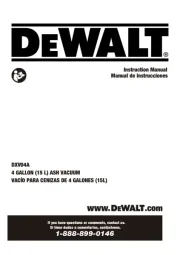
11 Juni 2025
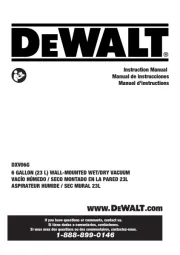
6 Juni 2025
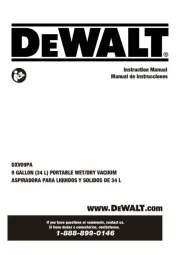
6 Juni 2025
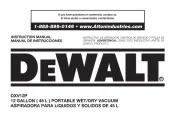
5 Juni 2025
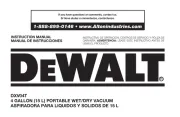
5 Juni 2025
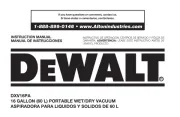
5 Juni 2025

9 Juni 2024

30 Augustus 2023

25 April 2023

28 Maart 2023
Handleiding Stofzuiger
- Biltema
- Arcelik
- Yato
- Lavex
- Clarke
- Morphy Richards
- Trifo
- Budget
- Robot
- Powerstar
- Intex
- Columbia Vac
- Makita
- EWT
- Ozito
Nieuwste handleidingen voor Stofzuiger
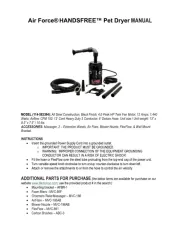
31 Juli 2025
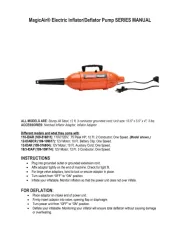
31 Juli 2025
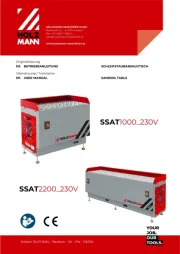
30 Juli 2025
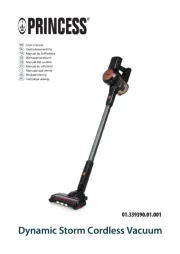
29 Juli 2025
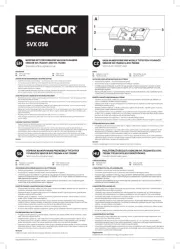
29 Juli 2025

29 Juli 2025
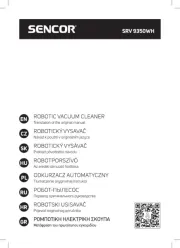
29 Juli 2025
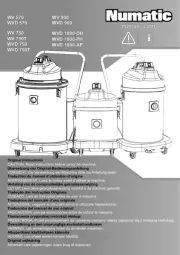
29 Juli 2025
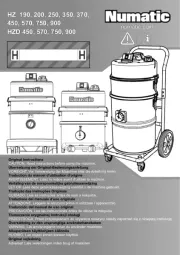
29 Juli 2025
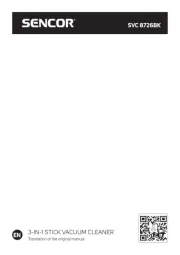
29 Juli 2025